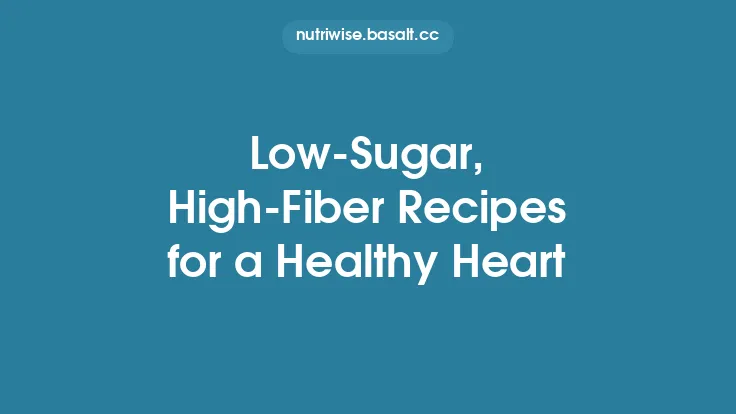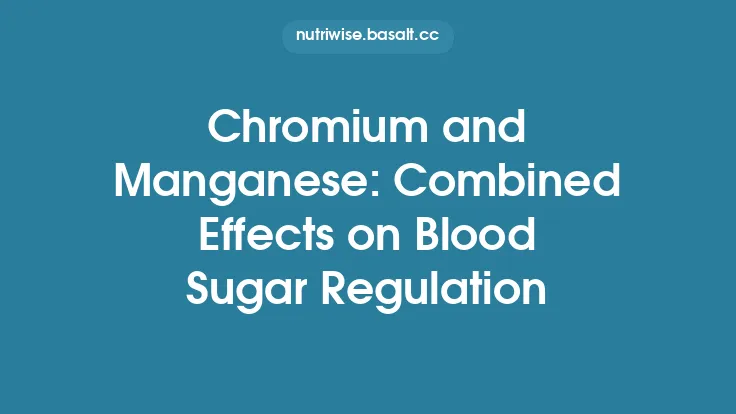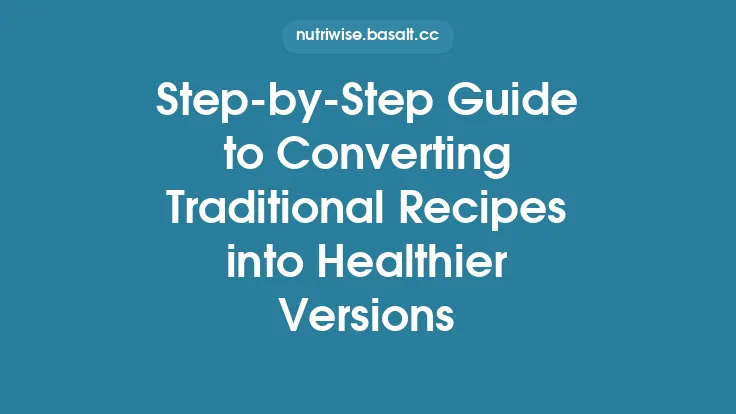Low‑heat sautéing is a deceptively simple cooking method that can have a profound impact on the nutritional quality of our meals, especially when the goal is to keep blood‑sugar levels steady. By gently coaxing vegetables, legumes, and even certain whole‑grain products through a brief, controlled heat exposure, we preserve the structural integrity of dietary fiber, protect heat‑sensitive phytochemicals, and limit the rapid breakdown of starches that would otherwise cause a spike in glucose. This article explores the science behind why low‑heat sautéing works, outlines the practical steps to master the technique, and offers guidance on incorporating it into a blood‑sugar‑friendly eating plan.
The Science of Fiber and Glycemic Response
Soluble vs. Insoluble Fiber
- *Soluble fiber* dissolves in water, forming a viscous gel that slows gastric emptying and blunts post‑prandial glucose excursions. Sources include oats, barley, psyllium, and the pectin in many fruits and vegetables.
- *Insoluble fiber* adds bulk, promotes regular bowel movements, and also contributes to a slower glucose rise by physically separating carbohydrate particles during digestion. It is abundant in wheat bran, nuts, seeds, and the skins of many vegetables.
Resistant Starch and Its Role
Resistant starch (RS) behaves like soluble fiber: it resists digestion in the small intestine and ferments in the colon, producing short‑chain fatty acids that improve insulin sensitivity. Low‑heat cooking helps retain RS, whereas high temperatures can gelatinize starches, making them more readily digestible.
Fiber’s Interaction with Enzymes
Enzymes such as α‑amylase and maltase break down starches into glucose. When fiber remains intact, it creates a physical barrier that limits enzyme access, thereby moderating the rate at which glucose appears in the bloodstream.
How Heat Affects Fiber Structure
Thermal Degradation Thresholds
- *Cellulose and hemicellulose* (major components of insoluble fiber) begin to degrade noticeably above 150 °C (302 °F).
- *Pectin* (soluble fiber) starts to solubilize around 80–90 °C (176–194 °F), which can be beneficial for texture but excessive breakdown reduces its gel‑forming capacity.
Maillard Reactions vs. Fiber Preservation
High‑heat sautéing (≥180 °C) accelerates Maillard browning, creating appealing flavors but also accelerates the breakdown of delicate fibers and can increase the formation of advanced glycation end‑products (AGEs), which have been linked to insulin resistance. Low‑heat sautéing keeps temperatures in the 90–130 °C (194–266 °F) range, striking a balance between flavor development and fiber integrity.
Water Loss and Concentrated Carbohydrates
Rapid evaporation at high heat concentrates sugars, raising the glycemic load of the final dish. Gentle sautéing retains more moisture, diluting the carbohydrate matrix and further stabilizing blood glucose.
Principles of Low‑Heat Sautéing
- Temperature Control – Use a medium‑low setting on the stovetop; the pan should be warm enough to produce a faint sizzle when a drop of water is added, but not so hot that the oil smokes.
- Short Cooking Times – Aim for 3–7 minutes total, depending on the size and density of the ingredients. The goal is to soften the cell walls just enough to make the food palatable while keeping fiber largely intact.
- Gentle Agitation – Stir or toss the food with a silicone spatula rather than vigorous shaking; this minimizes mechanical damage to fiber structures.
- Layered Addition – Add denser, high‑fiber items (e.g., carrots, broccoli stems) first, followed by softer components (e.g., leafy greens) to ensure even cooking without over‑cooking any single ingredient.
Choosing the Right Pan and Fat
Pan Material
- *Stainless steel* with an aluminum or copper core distributes heat evenly, allowing precise temperature maintenance.
- *Cast iron* retains heat well but can overshoot the low‑heat range unless the burner is set very low.
Surface Finish
A well‑seasoned non‑stick surface reduces the need for excess oil, which can otherwise add unnecessary calories and affect the glycemic response of the meal.
Fat Selection
- *Monounsaturated oils* (extra‑virgin olive oil, avocado oil) have a high smoke point and contribute beneficial fatty acids that improve insulin sensitivity.
- *Small amounts of nut oils* (e.g., walnut) add omega‑3s without overwhelming the dish.
- Avoid saturated fats with low smoke points (e.g., butter) unless clarified (ghee) to prevent burning at the low‑heat range.
Selecting Fiber‑Rich Ingredients
| Ingredient | Predominant Fiber Type | Approx. Fiber (g per 100 g) | Low‑Heat Suitability |
|---|---|---|---|
| Broccoli florets | Soluble & Insoluble | 2.6 | Excellent |
| Kale leaves | Insoluble | 3.6 | Excellent |
| Bell peppers | Soluble (pectin) | 1.5 | Good |
| Zucchini (with skin) | Insoluble | 1.1 | Good |
| Chickpeas (pre‑cooked) | Soluble & Resistant Starch | 7.6 | Good (add later) |
| Quinoa (pre‑cooked) | Insoluble | 2.8 | Add at end for texture |
| Mushrooms | Insoluble (chitin) | 1.0 | Excellent |
| Onions (thinly sliced) | Soluble (pectin) | 1.7 | Add early for flavor |
Tips for Maximizing Fiber
- Keep skins on whenever possible; they house a large proportion of insoluble fiber.
- Use whole‑grain products that have been cooked beforehand; reheating at low heat preserves RS.
- Pair high‑fiber vegetables with a modest amount of protein (e.g., tofu, tempeh) to further blunt glucose spikes.
Step‑by‑Step Low‑Heat Sauté Technique
- Preheat the Pan – Place the pan on a low burner for 1–2 minutes. Test the temperature by sprinkling a few drops of water; they should dance gently, not evaporate instantly.
- Add Fat – Pour 1–2 teaspoons of olive oil; swirl to coat the surface.
- Introduce Aromatics – Add minced garlic or ginger (optional) and sauté for 30 seconds, just until fragrant.
- Start with Dense Vegetables – Add carrots, broccoli stems, or other hard vegetables. Stir continuously for 2–3 minutes.
- Layer Softer Items – Add bell peppers, zucchini, mushrooms, and leafy greens. Continue stirring, monitoring that the pan does not become too dry; add a splash of water or broth if needed.
- Incorporate Pre‑Cooked Legumes or Grains – Toss in chickpeas or quinoa for the final 1–2 minutes, just to warm through.
- Season Lightly – Finish with a pinch of sea salt, freshly cracked pepper, and a squeeze of lemon juice (optional) to brighten flavors without adding sugar.
- Serve Immediately – Transfer to a plate to prevent residual heat from continuing to cook the vegetables.
Common Pitfalls and How to Avoid Them
| Pitfall | Why It Happens | Solution |
|---|---|---|
| Over‑cooking, leading to fiber breakdown | Temperature too high or cooking too long | Use a thermometer (aim for ≤130 °C) and set a timer. |
| Dry pan, causing scorching | Insufficient moisture or oil | Add a tablespoon of broth or water halfway through. |
| Uneven cooking | Crowding the pan, preventing heat distribution | Cook in batches; give each piece space to release steam. |
| Loss of flavor due to low heat | Insufficient Maillard development | Finish with a quick high‑heat sear (30 seconds) after the low‑heat phase, if desired, but keep the bulk of cooking low. |
| Excessive oil absorption | Pan not hot enough before adding oil | Preheat the pan briefly; oil should shimmer before ingredients are added. |
Integrating Low‑Heat Sautéed Dishes into a Blood‑Sugar‑Friendly Diet
- Meal Timing – Pair a low‑heat sautéed vegetable medley with a protein source (e.g., grilled tofu, boiled eggs) at each main meal to create a balanced macronutrient profile.
- Portion Control – Aim for half the plate to be non‑starchy vegetables, a quarter protein, and a quarter whole‑grain or legume.
- Snack Strategy – Use a small portion of low‑heat sautéed greens as a snack base, topped with a tablespoon of hummus for added protein and healthy fat.
- Batch Preparation – Cook a large batch of low‑heat sautéed vegetables on a weekend; store in airtight containers for up to 4 days. Reheat gently in a microwave or a quick pan‑warm to retain texture.
Practical Recipes
1. Low‑Heat Sautéed Mediterranean Veggie Mix
- 1 cup broccoli florets
- ½ cup sliced red bell pepper
- ½ cup zucchini rounds (skin on)
- ¼ cup sliced red onion
- ½ cup cooked chickpeas
- 1 tsp extra‑virgin olive oil
- ½ tsp dried oregano, pinch of sea salt, fresh lemon zest
*Method*: Follow the step‑by‑step technique above. Finish with lemon zest for a bright, sugar‑neutral flavor boost.
2. Herb‑Infused Low‑Heat Sautéed Kale & Mushrooms
- 2 cups chopped kale (stems removed)
- 1 cup sliced cremini mushrooms
- 1 tsp avocado oil
- ½ tsp garlic powder, ¼ tsp smoked paprika, pinch of black pepper
*Method*: Sauté mushrooms first (2 min), then add kale and continue until wilted but still bright green (≈3 min).
3. Quick Low‑Heat Sautéed Quinoa & Veggie Bowl
- 1 cup cooked quinoa (cooled)
- ½ cup diced carrots
- ½ cup frozen peas (thawed)
- 1 tsp olive oil
- ¼ tsp cumin, pinch of sea salt
*Method*: Sauté carrots first, add peas and quinoa, stir for 2 min until heated through.
Nutritional Considerations
- Fiber Retention – Studies show that low‑heat sautéing preserves up to 85 % of insoluble fiber compared with high‑heat methods that can degrade up to 30 % of the same.
- Glycemic Index (GI) Impact – By maintaining fiber structure, the effective GI of a mixed vegetable dish can drop by 10–15 points, translating to a slower glucose rise.
- Caloric Density – Using minimal oil (≤2 tsp per serving) keeps the dish low in added calories while still delivering the benefits of healthy fats.
Frequently Asked Questions
Q: Can I use a non‑stick pan for low‑heat sautéing?
A: Yes, a high‑quality non‑stick surface is ideal because it requires less oil and reduces the risk of sticking, which can lead to over‑cooking.
Q: Is it okay to add a splash of wine or vinegar?
A: Small amounts (≤1 tbsp) are fine; they add flavor without significantly affecting the glycemic response. Avoid sugary sauces or glazes.
Q: How do I know if my pan is too hot?
A: A quick test is to sprinkle a few droplets of water; they should sizzle gently and evaporate slowly. If they dance violently or disappear instantly, the pan is too hot.
Q: Does low‑heat sautéing work for root vegetables like sweet potatoes?
A: Yes, but because they are denser, they benefit from being cut into small, uniform cubes and may require a slightly longer sauté (≈8 min) while still staying below 130 °C.
Closing Thoughts
Low‑heat sautéing is more than a culinary shortcut; it is a strategic technique that aligns flavor, texture, and nutrition with the goal of stable blood‑sugar control. By respecting the thermal thresholds of fiber, choosing the right cookware and fats, and applying disciplined temperature management, home cooks can create vibrant, satisfying dishes that keep glucose spikes at bay. Incorporate this method regularly, pair it with balanced protein and healthy fats, and you’ll have a reliable tool in your culinary arsenal for long‑term metabolic health.





